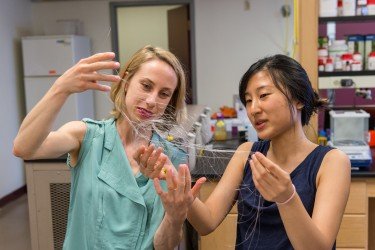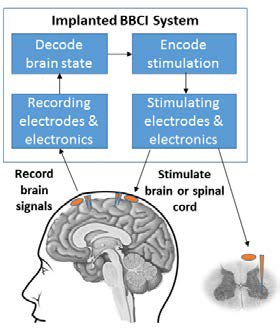 That’s the mission driving the Center for Sensorimotor Neural Engineering, a University of
That’s the mission driving the Center for Sensorimotor Neural Engineering, a University of
To support development of this
«There’s a huge unmet need, especially with an aging population of baby boomers, for developing the next generation of medical devices for helping people with progressive or traumatic neurological conditions such as stroke and spinal cord injury," said CSNE director and UW professor of computer science and engineering Rajesh Rao.
The goal is to achieve
CSNE was founded in 2011 with an $18.5 million NSF grant. Since then, its interdisciplinary team of neuroscientists, engineers, computer scientists, neurosurgeons, ethicists and industry partners has led the way in developing
 The devices record and decode electrical signals generated by the brain when a person forms an intention, for example, to move a hand to pick up a cup. The devices are also able to wirelessly transmit that information, essentially creating a new artificial pathway around damaged areas of the brain or nervous system.
The devices record and decode electrical signals generated by the brain when a person forms an intention, for example, to move a hand to pick up a cup. The devices are also able to wirelessly transmit that information, essentially creating a new artificial pathway around damaged areas of the brain or nervous system.
«When Christopher Reeve sustained a spinal cord injury due to a fall from his horse, his brain circuits were still intact and able to form the intention to move, but unfortunately the injury prevented that intention from being conveyed to the spinal cord," Rao said.
«Our implantable devices aim to bridge such lost connections by decoding brain signals and stimulating the appropriate part of the spinal cord to enable the person to move again," he said.
The same technology could also be used to promote plasticity for targeted rehabilitation in stroke and spinal cord injury patients — essentially reconnecting brain or spinal regions and helping the nervous system repair and rewire itself.
CSNE is also working on improving today’s implantable technologies, such as deep brain stimulators used to treat Parkinson’s disease and tremors. These typically deliver electric pulses to the brain at an appropriate frequency that’s adjusted by a physician to achieve the desired effect.
But this means that the brain is constantly bombarded by electrical pulses even when a person is resting and the pulses aren’t needed. This can lead to unwanted side effects and drain the implantable device’s battery, leading to more frequent replacement surgeries.
By contrast, CSNE researchers and industry partners are working on a next generation of «closed loop» implantable devices that monitor the brain and deliver targeted electrical stimulation only when it’s needed.
«This funding renewal for CSNE will allow us to advance the frontiers in
The NSF funding will also enable the center to expand its already popular outreach and education programs for
Other CSNE collaborators include Spelman College, Morehouse College, Southwestern College, the University of British Columbia, the University of Freiburg and the Indian Institute of Science in Bangalore.
Source: http://www.washington.edu/news/2015/12/28/uw-center-receives-16m-to-work-on-first-implantable-device...

